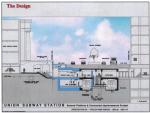Several reader comments recently talk about various design changes that might be made for Union Station Loop and surrounding areas. My gut feeling from many of these is that the three-dimensional layout of existing and planned structures in this area is not well understood.
To assist, to the degree I can, this post includes some drawings from the past year and a discussion of how things fit together. Some of these drawings are partly out of date and they must be read in connection with my notes here. The intention is to give an overview, not a definitive set of plans. The linked images have an aspect ratio wider than the thumbnails and more is visible in the large versions.
This is a cross section through the subway station looking west with the second platform (in blue) added. Although not obvious on this drawing, a new glass wall will be added between the south edge of the existing platform and the northbound-to-Yonge track. The escalator and stairway access to the northbound-to-University platform will be moved to the south edge of this platform giving more space for passengers between the University track and the vertical access paths to the mezzanine.
Also visible in this drawing is a stair up to the moat level from the mezzanine level of the station. This design predates the “dig down” plans for the GO concourse. The new lower concourse will be on the same level as the subway mezzanine with a straight access through a lowered moat between the two areas.
Note also that there is a sewer under the moat. This must be lowered to permit the direct access across the moat.
The mezzanine of the subway station is immediately under street level. There is no room here to insert an east-west Front Street LRT station below grade.
Note to the TTC: When are they going to put current information and detailed plans up on the web page which has not been updated (only reformatted) since 2006? This in an important project, but one needs a personal archive and other sites’ data to see what is going on here.

